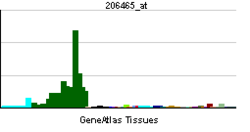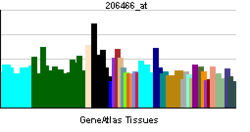ACSBG1
| View/Edit Human | View/Edit Mouse |
Acyl-CoA Synthetase, Bubblegum Family, member 1 (ACSBG1) is an enzyme that in humans is encoded by the ACSBG1 gene.[3][4][5]
The protein encoded by this gene possesses long-chain acyl-CoA synthetase activity. It is thought to play a central role in brain very long-chain fatty acids metabolism and myelinogenesis.[5] The conversion of long chain fatty acids into long chain acyl-CoAs in mice is catalysed by ACSBG1.[6]
References
- ↑ "Human PubMed Reference:".
- ↑ "Mouse PubMed Reference:".
- ↑ Ishikawa K, Nagase T, Suyama M, Miyajima N, Tanaka A, Kotani H, Nomura N, Ohara O (Dec 1998). "Prediction of the coding sequences of unidentified human genes. X. The complete sequences of 100 new cDNA clones from brain which can code for large proteins in vitro". DNA Res. 5 (3): 169–76. doi:10.1093/dnares/5.3.169. PMID 9734811.
- ↑ Steinberg SJ, Morgenthaler J, Heinzer AK, Smith KD, Watkins PA (Nov 2000). "Very long-chain acyl-CoA synthetases. Human "bubblegum" represents a new family of proteins capable of activating very long-chain fatty acids". J Biol Chem. 275 (45): 35162–9. doi:10.1074/jbc.M006403200. PMID 10954726.
- 1 2 "Entrez Gene: ACSBG1 acyl-CoA synthetase bubblegum family member 1".
- ↑ Moriya-Sato A, et al. (Dec 2000). "Novel acyl-CoA synthetase in adrenoleukodystrophy target tissues.". Biochem Biophys Res Commun. 279 (1): 62–8. doi:10.1006/bbrc.2000.3897. PMID 11112418.
External links
- Human ACSBG1 genome location and ACSBG1 gene details page in the UCSC Genome Browser.
Further reading
- Andersson B, Wentland MA, Ricafrente JY, et al. (1996). "A "double adaptor" method for improved shotgun library construction.". Anal. Biochem. 236 (1): 107–13. doi:10.1006/abio.1996.0138. PMID 8619474.
- Yu W, Andersson B, Worley KC, et al. (1997). "Large-scale concatenation cDNA sequencing.". Genome Res. 7 (4): 353–8. doi:10.1101/gr.7.4.353. PMC 139146
 . PMID 9110174.
. PMID 9110174. - Moriya-Sato A, Hida A, Inagawa-Ogashiwa M, et al. (2001). "Novel acyl-CoA synthetase in adrenoleukodystrophy target tissues.". Biochem. Biophys. Res. Commun. 279 (1): 62–8. doi:10.1006/bbrc.2000.3897. PMID 11112418.
- Strausberg RL, Feingold EA, Grouse LH, et al. (2003). "Generation and initial analysis of more than 15,000 full-length human and mouse cDNA sequences.". Proc. Natl. Acad. Sci. U.S.A. 99 (26): 16899–903. doi:10.1073/pnas.242603899. PMC 139241
 . PMID 12477932.
. PMID 12477932. - Pei Z, Oey NA, Zuidervaart MM, et al. (2004). "The acyl-CoA synthetase "bubblegum" (lipidosin): further characterization and role in neuronal fatty acid beta-oxidation..". J. Biol. Chem. 278 (47): 47070–8. doi:10.1074/jbc.M310075200. PMID 12975357.
- Fraisl P, Forss-Petter S, Zigman M, Berger J (2004). "Murine bubblegum orthologue is a microsomal very long-chain acyl-CoA synthetase.". Biochem. J. 377 (Pt 1): 85–93. doi:10.1042/BJ20031062. PMC 1223850
 . PMID 14516277.
. PMID 14516277. - Ota T, Suzuki Y, Nishikawa T, et al. (2004). "Complete sequencing and characterization of 21,243 full-length human cDNAs.". Nat. Genet. 36 (1): 40–5. doi:10.1038/ng1285. PMID 14702039.
- Asheuer M, Bieche I, Laurendeau I, et al. (2005). "Decreased expression of ABCD4 and BG1 genes early in the pathogenesis of X-linked adrenoleukodystrophy.". Hum. Mol. Genet. 14 (10): 1293–303. doi:10.1093/hmg/ddi140. PMID 15800013.
This article is issued from Wikipedia - version of the 11/30/2016. The text is available under the Creative Commons Attribution/Share Alike but additional terms may apply for the media files.

